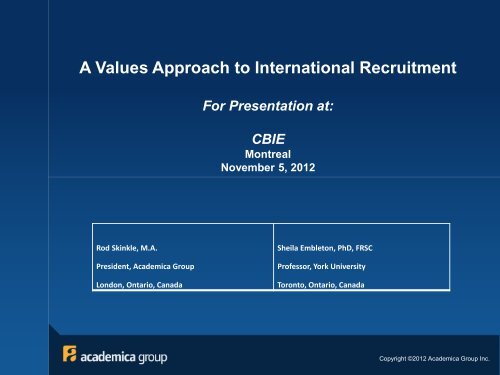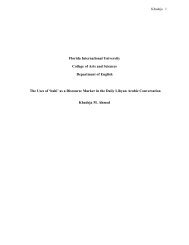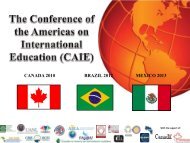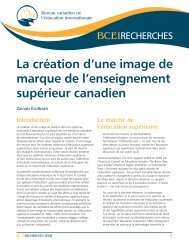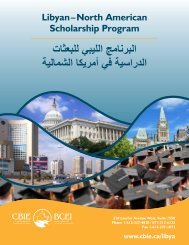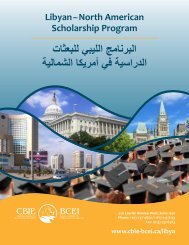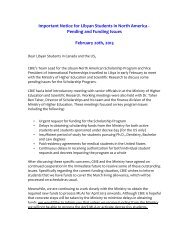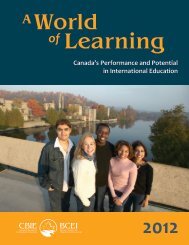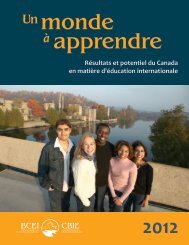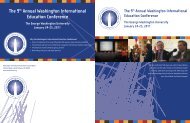International -Study -PRESENTATION -FINAL-VERSION .pdf
International -Study -PRESENTATION -FINAL-VERSION .pdf
International -Study -PRESENTATION -FINAL-VERSION .pdf
- No tags were found...
Create successful ePaper yourself
Turn your PDF publications into a flip-book with our unique Google optimized e-Paper software.
A Values Approach to <strong>International</strong> RecruitmentFor Presentation at:CBIEMontrealNovember 5, 2012Rod Skinkle, M.A.President, Academica GroupLondon, Ontario, CanadaSheila Embleton, PhD, FRSCProfessor, York UniversityToronto, Ontario, CanadaCopyright ©2012 Academica Group Inc.
Conditions for Success (and Mediocrity)are just rightSuccess factors include:- Market Growth- National education brand and promotion program- Canada (as destination)– English language– Safe, stable, “tolerant”, good “quality of life”– Costs reasonable– Quality good– Overall image of country as “pleasant”2
Conditions for Success (and Mediocrity)are just rightChallenge factors include:− National strategy vs. provincial jurisdiction− Most provinces lack coordinated effort− Competitive growth increasing dramatically− <strong>International</strong> student awareness/knowledge very low− Most don’t understand Canadian College/University− Canada behind US, UK, Australia (e.g. Indian sample)− Individual institutional brands low3
Conditions for Success (and Mediocrity)are just rightChallenge factors continued…− Institutional strategies in their infancy− Goals not well articulated− Success not clear (nor failure)− Costs not understood− 60% acknowledge services lag enrolment− Therefore, ROI not known4
Conditions for Success (and Mediocrity)are just rightRecommendation?Reliable/objective data needed (this investigation)5
Our Research Overview• Phase 1 – <strong>International</strong> Student Prospect Survey (India)– Purposive sample of 59 Indian schools selected to geographicallyrepresent the top 200 private schools from Feb 15 – July 6, 2011– In class: Supervised paper surveys– 5,117 completed surveys– Confidence Interval: ±2.9%, 19 times out of 20.• Phase 2 – Institutional Strategy Survey– Convenience sample of 230 contacts representing 83 (50 universities,33 colleges) across Canada, April 2012– Purposive selection to represent 10 provinces (1 territory) and a rangeof institutional sizes– Target Administrators (typically director level, involved in international)– A total of 65 respondents from 54 institutions – response rate 28%.6
Survey of <strong>International</strong> StudentProspects1Highlights: Prospect <strong>International</strong>StudentsPriority factors in selecting adestination school
• of the 5000+ private high school students in IndiaHigher Education PlansAmong All Students n=5,117Level of Intention for <strong>Study</strong>ing AbroadAmong Students Expecting/Considering Studies Outside India, n=1,070I don't plan tocontinue toHigherEducation,37%I expect tostudy outsideIndia, 13%I’mconsideringstudyingoutside India,8%21% percent are expectingVery likely54%(13%) or considering (8%)studies outside of IndiaSomewhat likely29%Not at all likely1%I willcontinue tostudy inIndia, 42%Don`t know16%8
What will they study?Students who are interested in studies abroad are morelikely to be considering graduate studies.Business graduate degree (MBA)33%29%Master's degree (e.g. MA, MSc)Doctorate degree (PhD)University bachelor’s degreeProfessional diploma (e.g. art, design, computers)Law degreeMedical degree (MD, DDS, DVS)Teaching degreeDon’t know21%16%15%10%9%10%8%8%7%7%4%7%1%1%14%13%Multiple MentionsConsidering/Expecting to <strong>Study</strong> Outside of India, n=1070Not considering Studies Outside of India, n=21399
Interest in graduate studiesBusiness graduate degree (MBA)33%29%Students who are interested in studies abroad are morelikely to be considering graduate studies.Master's degree (e.g. MA, MSc)Doctorate degree (PhD)University bachelor’s degreeProfessional diploma (e.g. art, design, computers)21%16%15%10%9%10%8%8%Considering/Expecting to <strong>Study</strong> Outside of India, n=1070Not considering Studies Outside of India, n=213910
Top StudentPrioritiesReputationVery Important Somewhat Important Not ImportantAcademic reputation of institution68%13% 19%Quality of faculty (professors/instructors)59%19% 21%Academic reputation of program/major57%22% 21%Reputation for student experience51%24%25%Graduates get high-quality jobs47%24%30%Campus safety/security46%23%31%Mean2.52.42.42.32.22.2TeachingStudent ExperienceHigh quality jobsGraduates get into top professional and grad schoolsHigh-profile researchHigh admission grade point averageUndergraduate research opportunitiesProfessor/instructor-student interactionInstitutional rankings/guidebook ratingsOpportunities for student leadershipPersonal attention during application/admission process46%46%45%44%42%42%39%38%25%30%33%32%27%31%31%28%29%24%23%25%30%27%30%35%2.22.22.22.22.12.22.12.039InfluenceFactorsResearch / LeadershipOpportunitiesAttractive campusCo-op programs/internshipsTuition costsAvailability of financial support for international studentsCampus housing/residences37%36%35%35%35%34%33%27%27%35%30%31%38%37%30%2.12.12.02.02.1Off-campus urban life35%35%30%2.1Lowest StudentPrioritiesSmall classesNational/professional accreditationPart-time job opportunitiesCosts of attending, excluding tuitionClubs and social activitiesRecreational sports/fitness facilitiesAcceptance of my previous creditsEasy to get accepted34%33%33%33%32%28%27%32%30%30%35%36%32%31%34%37%38%33%32%40%42%2.02.02.02.02.01.91.9History / TraditionAvailability of off-campus housingOnline access to lecture videos and materialsSmall class sizes25%24%23%39%37%34%36%39%44%1.91.91.8Student DiversityHistory/tradition of schoolRelevant industry in the areaDiversity of student population21%20%18%37%29%40%42%51%41%1.81.71.8SurroundingCommunityLarge student populationReligious considerationsSmall student populationSmall surrounding community15%14%13%12%39%24%33%32%47%63%54%56%1.71.51.61.6Institution is close to family12%21%68%1.4Attending the school your parent(s) or other family member … 10%17%73%1.411
Results– <strong>International</strong>ization Profile acrossCanadian Institutions2the state of the nation
Proportion of Institutions with <strong>International</strong> StrategiesOverall, 72% have an international strategy in place• 52% implemented this strategy within the past four years• a larger proportion of universities did so in the past two yearsNo19%<strong>International</strong>StrategyUnsure9%Yes72%Year <strong>International</strong>ization StrategyImplementedTotal Universities Colleges2011-2012 18% 22% 8%2009-2010 33% 33% 33%2007-2008 21% 19% 25%Before 2007 8% 7% 8%No answer 21% 19% 25%UniversitiesColleges73% 71%Base: Total – n=54 Institutions: Universities – n=37; Colleges – n=1713
Proportion of Int’l Students within Student Body and TargetsUniversities and colleges both report similar proportions of international studentsIncreases Planned: 73% of universities 47% of CollegesCurrent Proportion of Int’l StudentsEstablished Targets to Increase ProportionLess than 3%5%19%UniversitiesColleges3.0 - 4.9%5.0 - 9.9%10 - 19.9%20%+8%6%5%6%49%25%30%44%No22%Unsure5%Yes73%No41%Unsure12%Yes47%Not specified3%0%Universities CollegesMean 9.3% 9.0%Median 8% 8%Interesting Notes:• Majority of institutions in eastern Canada report a relativelyhigh proportion of international students ranging from 11% to 25%.• Colleges in the GTA report higher proportions ranging from 12% to 30%.Base: Total – n=53 Institutions: Universities – n=37; Colleges – n=16 (Note: One outlier wasremoved (reported “65%” ) from data set)14
<strong>International</strong> Plans with Revenue TargetsOver one-third report that plans include set revenue targets• Colleges significantly more likely (65% vs. 22%)Proportion of Institutions with Revenue TargetsUnsure19%Prefer notto answer11% Universities CollegesYes35%Yes 22% 65%No35%No 43% 18%Not sure 24% 6%Prefer not to say 11% 12%Base: Total – n=54 Institutions: Universities – n=37; Colleges – n=1715
<strong>International</strong>ization RecruitmentStrategies and Initiatives3
Target Countries for <strong>International</strong> Enrolment Plans• Over 1/3 report they have set target countries.• A diverse set of countries, with China and India remaining the two top sources• Brazil (universities) and Mexico (colleges) also rank high.Target Countries in Enrolment PlansUnsure9%No54%UniversitiesYes37%CollegesTarget Countries of Key ImportanceTotalUniversities(n=16)**Colleges(n=8)**China 92% 100% 75%India 88% 81% 100%Brazil 54% 63% 38%United States 42% 44% 38%Mexico 38% 19% 75%Turkey 38% 38% 38%Vietnam 38% 31% 50%Russia 33% 31% 38%South Korea 33% 25% 50%Indonesia/Malaysia 29% 19% 50%Japan 29% 19% 50%Latin American region 25% 19% 38%Middle East Region 25% 31% 13%Germany 17% 25% 0%36% 40%Base: Total – n=65 Respondents: Universities – n=45; Colleges – n=2017
Programs that are Promoted for Int’l Student EnrolmentUniversities promote undergraduate degrees most, and graduate leveldegrees (Master’s and PhDs)UniversitiesCollegesShort term less than 8 week study program 36% 30%College certificate 1year program - 80%College diploma 2year program - 100%College advanced diploma 3year program - 75%A 2 Plus 2, 3 plus 1, or 2 Plus 1 Program 62% 70%A joint degree program 36% 15%A dual degree program 42% 10%College degree 4year program - 80%University undergraduate degree 96% 20%College post-graduate certificate - 70%Teaching degree 27% -Master’s degree 60% -Business graduate degree, MBA 60% -Law degree 18% -Medical degree 4% -Doctorate degree PhD 47% -Other 20% 30%Don't know 2% -Base: Total – n=65 Respondents: Universities – n=45; Colleges – n=2018
Priority <strong>International</strong>ization Initiatives – Summary ComparisonThe internationalization strategies of universities are much more diversifiedoverall compared to colleges.UniversitiesCollegesInt'l student recruitment plans - 4.8Int’l student support services - 4.6Undergraduate int'l student recruitment plans 4.7 -Undergraduate int'l student support services 4.4 -Developing strategic partnerships with institutions outside of Canada 4.4 4.0Offering int'l exchange opportunities 4.1 3.6<strong>International</strong> research collaboration 3.9 2.4Graduate int'l student recruitment plan 3.7 -Graduate int'l student support services 3.7 -Identification and exploitation of int'l funding sources 3.5 2.9<strong>International</strong>ization of curricula 3.5 2.8Development assistance programming 3.2 2.7Base: University Respondents – n=45; College Respondents – n=2019
Int’l Student Service Levels haven’t Kept Pace with GrowthOverall, less than half of the administrators we surveyed (41% rated “5” or“4”) feel that international student service levels at their institution havekept pace with the growth of international recruitment.5-Very much 4 3-Somewhat 2 1-Not at allMeanTotal15%26%40%11%8%3.3UniversitiesUniversities16%22%44%9%9%3.3CollegesColleges15%35%30%15%5%3.4Base: Total – n=65 Respondents: Universities – n=45; Colleges – n=2020
Anticipated Challenges with<strong>International</strong> Student Recruitment,Retention and Integration4
Anticipated Challenges – Summary Comparison• There are more similarities than differences with regard to the top 3 anticipated challenges• sufficient student service levels,• refereeing academic standards (greater concern among colleges),• achieving and maintaining enrolment targets.Total Universities CollegesProviding sufficient student service levels 3.8 3.8 3.7Refereeing academic standards – plagiarism, referencing 3.7 3.6 4.0Achieving and maintaining enrolment targets 3.7 3.6 3.9Achieving and maintaining a balance of international student enrolmentacross programs/Faculties3.6 3.7 3.5Achieving and maintaining on-campus social/community integration 3.5 3.5 3.6Understanding specific international markets 3.5 3.4 3.7Adapting recruiting efforts internationally 3.5 3.5 3.4Achieving and maintaining academic quality/performance standards 3.4 3.4 3.3Achieving and maintaining English/French language proficiency levels 3.4 3.5 3.1Achieving and maintaining an appropriate balance between domestic andinternational students on campusUnderstanding and providing for unique cultural/religious studentneeds3.3 3.4 3.03.3 3.2 3.4Lack of faculty interest and involvement 3.2 3.2 3.1Achieving and maintaining off-campus social/community integration 3.1 3.2 2.9Base: Total – n=65 Respondents: Universities – n=45; Colleges – n=2022
Conditions for Success (and Mediocrity)are just rightRecommendation?− a values approach to international recruitment23
Values Approach to <strong>International</strong>Recruitment1. Establish Goals– Take stock now (preliminary assessment in relation togoals)2. Develop/refine strategy to achieve those goals3. Establish indicators of success (criteria)– Establish baseline now and measure (regularly)24
1) Establish Goals and Take Stock NowThere is an implicit assumption that the experience of living and studying within adifferent culture provides real benefits for both international students and domesticstakeholders alike.Canadian Institutional Stated Benefits1. Personal and career development for the international students through the educationand experience of living and studying in Canada.2. Enhanced learning and personal development for the domestic student populationresulting from studying alongside international students.3. Financial benefits for the host institution deriving primarily from the higher tuition andrelated local spending, but also the potential for international students to benefit thenation through permanent immigration.25
DISCUSSION1. Personal and career development for the internationalstudents through the education and experience of living andstudying in Canada.Personal development and the ‘quality’ of the Canadian education are not examinedin this UNBSJ study. However, Graduate this Preparation research identifies Series (GPS), several designed disconnects to help between senior-levelinternational student aspirations and institutional realities:international students plan and prepare for their final year as well as forlife as a new graduate in a professional working environment (sessions on• Over half of administrators acknowledge support services are lagging internationalstudente.g. careergrowthpath development, job hunting, mock interviews) followed by• Few paid institutions internship have with established local business/organizationinternational student specific programing in• Career goal development• Leadership development• Graduate program advising26
2. Enhanced learning and personal development forthe domestic student population resulting fromstudying alongside international students.Proportion of Students Considered or Applied to<strong>Study</strong> AbroadCountries Considered/Applied toAmong those who considered/applied to PSI outside of CanadaBase: All Applicants to PSEUnited States12%63%Yes, 18%UnitedKingdom4%41%Australia1%30%No, 82%FranceNew ZealandChina
Three broad recommendations forCanada and other countries:1. National and sub-national governments must work more effectively togetherto develop not only strategies, but also mechanisms for monitoring success.The goal should be to provide a reliable basis for learning from internationalstudent experiences in order to better meet the aspirations of these studentsand to more firmly establish a meaningful service contract of value to allstakeholders (including the institution’s and the community's aspirations).2. There needs to be a broader discussion and recognition of the full costs ofrecruiting and retaining international students in Canada. It seems clear thatmany post-secondary institutions maintain an abiding focus on increasinginternational student enrolments in the absence of a concomitant plan toensure that funding is available to support international students properly andthus to ensure educational and career outcomes worthy of Canadianinstitutions.28
Three Recommendations continuedThree major recommendations for Canada and other countries, continued:3. Post-secondary institutions need to effectively shift their focus frominternational students as a “commodity” to a “values” perspective thatrecognizes their educational and career aspirations. This may involve areprioritization of services offered, to focus more on graduate programcounselling, professional development, and internship programs, or thedevelopment of whole new offerings that link international students directlyto their chosen career path—whether in Canada, or their own countries.29
Thank You!Rod Skinklerod@academicagroup.caSheila Embletonembleton@yorku.ca


